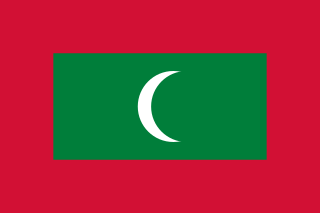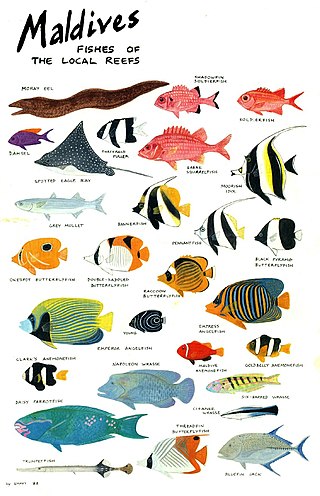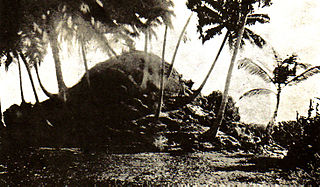

Buddhism was the predominant religion in the Maldives until at least the 12th century CE. It is not clear how and when Buddhism was introduced into the islands. [1]


Buddhism was the predominant religion in the Maldives until at least the 12th century CE. It is not clear how and when Buddhism was introduced into the islands. [1]
Western interest in the archaeological remains of early cultures on the Maldives began with the work of H. C. P. Bell, a British commissioner of the Ceylon Civil Service. Bell was shipwrecked on the islands in 1879, and returned several times to investigate ancient Buddhist ruins. He studied the ancient mounds, called havitta or ustubu (these names are derived from chaitiya or stupa) (Dhivehi : ހަވިއްތަ) by the Maldivians, which are found on many of the atolls. [2]
Although Bell claimed that the ancient Maldivians followed Theravada Buddhism in the same manner as their Sinhalese ancestors from neighboring Sri Lanka, [2] Maldivian Buddhist archaeological remains that were preserved in the Malé Museum display in fact Mahayana and Vajrayana iconography. [3]
According to a legend of the Maldivian Folklore, a prince named Koimala from India or Sri Lanka entered the Maldives from the North (Ihavandhu) and became the first king from the House of Theemuge. Prior to that the Maldives had been settled by people of Dravidian origin from the nearest coasts, like the group today known as the Giravaaru who claim ancestry from ancient Tamils. It is unlikely that the Giraavaru islanders were the only early settlers in the Maldives. The importance they have been given is because they are mentioned in the legend about the establishment of the capital and kingly rule in Malé. The Giraavaru people were just one of the island communities predating Buddhism and the arrival of a Northern Kingly dynasty and the establishment of centralized political and administrative institutions.
The ancient Maldivian Kings promoted Buddhism and the first Maldive writings and artistic achievements in the form of highly developed sculpture and architecture are from that period. The conversion to Islam is mentioned in the ancient edicts written in copper plates from the end of the 12th century AD. There is also a locally well-known legend about a foreign saint (Persian or Moroccan according to differing versions) who subdued a demon known as Rannamaari.
Over the centuries, the islands have been visited and their development influenced by sailors and traders from countries on the Arabian Sea and the Bay of Bengal. Until relatively recent times, Mappila pirates from the Malabar Coast harassed the islands.
In February 2012, a group of Islamic extremists forced their way into the National Museum in Malé and attacked the museum's collection of pre-Islamic sculptures, destroying or severely damaging nearly the entire collection of about thirty Buddhist sculptures dating from the 6th to 12th centuries. [4] Museum staff indicated that as the sculptures were made from very brittle coral or limestone it would be impossible to repair most of them, and only two or three pieces were in a repairable condition. [4]


The Maldives, officially the Republic of Maldives, is a country and an archipelagic state in South Asia, situated in the Indian Ocean. It lies southwest of Sri Lanka and India, about 750 kilometres from the Asian continent's mainland. The Maldives' chain of 26 atolls stretches across the equator from Ihavandhippolhu Atoll in the north to Addu Atoll in the south.

The history of the Maldives is intertwined with the history of the broader Indian subcontinent and the surrounding regions, comprising the areas of South Asia and Indian Ocean; and the modern nation consisting of 26 natural atolls, comprising 1194 islands. Historically, the Maldives had a strategic importance because of its location on the major marine routes of the Indian Ocean. The Maldives' nearest neighbours are the British Indian Ocean Territory, Sri Lanka and India. The United Kingdom, Sri Lanka and some Indian kingdoms have had cultural and economic ties with the Maldives for centuries. In addition to these countries, Maldivians also traded with Aceh and many other kingdoms in, what is today, Indonesia and Malaysia. The Maldives provided the main source of cowrie shells, then used as a currency throughout Asia and parts of the East African coast. Most probably Maldives were influenced by Kalingas of ancient India who were earliest sea traders to Sri Lanka and the Maldives from India and were responsible for the spread of Buddhism. Stashes of Chinese crockery found buried in various locations in the Maldives also show that there was direct or indirect trade contact between China and the Maldives. In 1411 and 1430, the Chinese admiral Zheng He 鄭和 visited the Maldives. The Chinese also became the first country to establish a diplomatic office in the Maldives, when the Chinese nationalist government based in Taipei opened an embassy in Malé in 1966. This office has since been replaced by the embassy of the People's Republic of China.

This is a demography of the population of Maldives, including population density, ethnicity, education level, health of the populace, economic status, religious affiliations and other aspects of the population.
Vaadhoo is an inhabited island of Gaafu Dhaalu region in the atoll of Huvadhu, Maldives. It has its own dialect of Maldivian, which is considerably different from northern and Mid-Maldivian speech.
Dhanbidhoo or Dambidū is one of the inhabited islands of Haddummati Atoll, administrative code Laamu.

Isdhoo or Isdū is one of the inhabited islands of Haddhunmathi Atoll, administrative code Laamu part of Maldives in the Indian Ocean.
Giraavaru is an island of Malé Atoll nowadays hosting a tourist resort. It is located on the southwestern fringe of the lagoon of North Malé Atoll. It was inhabited in the past by the community known as Giraavaru people.

The culture of the Maldives is derived from a number of sources, the most important of which is its proximity to the shores of Sri Lanka and South India. The population is mainly Indo-Aryan from the anthropological point of view. Islam is considered the religion of the country and only Muslims can become legal citizens.

Dhives Akuru, later called Dhivehi Akuru is a script formerly used for the Maldivian language. The name can be alternatively spelled Dives Akuru or Divehi Akuru using the ISO 15919 Romanization scheme, as the "d" is unaspirated.
Several Dhivehi scripts have been used by Maldivians during their history. The early Dhivehi scripts fell into the abugida category, while the more recent Thaana has characteristics of both an abugida and a true alphabet. An ancient form of Nagari script, as well as the Arabic and Devanagari scripts, have also been extensively used in the Maldives, but with a more restricted function. Latin was official only during a very brief period of the Islands' history.

Hinduism in the Maldives describes the practice of the Hindu religion in the Maldives archipelago. Evidence suggests that Hinduism had a presence in pre-Islamic Maldives. Archaeological remains survive from the 8th or 9th century CE portraying Hindu deities such as Shiva, Lakshmi and the sage Agastya.

Established on the National Day of the Maldives, the first National Museum of the country was opened on 11 November 1952, by the Prime Minister at the time, Mohamed Amin Didi.
Maldivian mythology or Maldivian folklore is the body of myths, tales and anecdotes belonging to the oral tradition of Maldivians. Even though some of the Maldivian myths were already mentioned briefly by British commissioner in Ceylon HCP Bell towards the end of the 19th century, their study and publication were carried out only quite recently by Spanish writer and artist Xavier Romero-Frias, at a time when that ancestral worldview was quickly disappearing.

Haddhunmathi or LaamuAtoll is an administrative division of the Maldives. The administrative capital is Fonadhoo Island. It corresponds to the natural atoll of the same name. It is mostly rimmed by barrier reefs, the broadest of which are topped by islands. There are many islands along its eastern and southern boundaries. This atoll is quite regular excepting for the projection of the reef at its NE corner. It closely resembles Kolhumadulhu, its neighbour further north. Owing to its typical atoll shape, it differs in no respect from atolls in the Pacific Ocean, save for its greater size. Its reefs are generally of little breadth, with no signs of vilu, except for its eastern fringes which are covered with islands that are quite large by Maldivian standards. The lagoon is comparatively open, containing scattered shoal patches; the bottom is muddy and the average depth is from 30 to 34 fathoms.
Koimala Siri Mahaabarana Mahaa Radun or Koimala or Koimala Kalo is the last pre-Islamic and the earliest verifiable ruler of the Maldives. He reigned from A.D. 1117 to A.D. 1141.
The Giraavaru people are indigenous people of the Giravaaru islands that is part of Maldives. They are considered to be the earliest island community of the Maldives, predating Buddhism and the arrival of Indo-Aryan speakers in the archipelago. Their ancestors were ancient Tamil people who they referred to as 'Tamila'. Other mainstream Maldivians considered them to be of lower social status. They lived on the island of Giravaru until 1972, but were later relocated to Male', the nation's capital where they were assimilated in with the local social groups.

Maldivians are an Indo-Aryan ethnic group and nation native to the historic region of the Maldive Islands, present day Republic of Maldives and the island of Minicoy in Union Territory of Lakshadweep, India. All Maldivians share the same culture and speak the Maldivian language, which is a member of the southern group of Indo-Aryan languages. For ethnographic and linguistic purposes as well as geopolitical reasons, anthropologists divide the Maldivian people into three subgroups.

Xavier Romero Frías is a Spanish writer and scholar. He lived among the Maldivians over a 13-year period. His present residence is in Bangkok, Thailand.

Maldivian, also known by its endonym Dhivehi or Divehi, is an Indo-Aryan language spoken in the South Asian island country of Maldives and on Minicoy Island, Lakshadweep, a union territory of India.

Fua Mulaku Havitta is the ruin of a Buddhist chaitya whose main feature is its ruined stupa. The Havitta is located at the northeastern end of Fuvahmulah, Maldives. It was historically located in Dhadimagu ward of the island, in an area which has now been annexed to Hoadhadu ward. Being the most important center of the Buddhist community in the pre-Islamic period, Dhadimagu was the last ward of the island to have accepted Islam. It was after the acceptance of Islam by the residents of Dhadimagu ward that the Havitta was buried under a mound of sand and one of the temples in the area was converted into a mosque to be known as Gemmiskiy. This happened in the early 1200s under the leadership of Abu Bakr Naib, who completed the conversion process in Fuvahmulah started by his great grandfather Yoosuf Naib in the year 1145 CE.